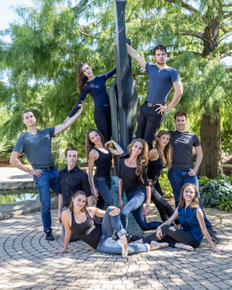 What struck me most about Ballet Quad Cities' Saturday-night performance of The Sleeping Beauty was how easy it was to follow the storyline even though it was told entirely in dance (set to Peter Ilich Tchaikovsky's score), and featured absolutely no dialogue.
What struck me most about Ballet Quad Cities' Saturday-night performance of The Sleeping Beauty was how easy it was to follow the storyline even though it was told entirely in dance (set to Peter Ilich Tchaikovsky's score), and featured absolutely no dialogue.
Of course, it helped that the tale of a princess destined to prick her finger at age 18 and, through a modified curse, fall into a deep sleep is a familiar one, and that the details of this version were clearly described in the show's program. But even with that advance knowledge of the plot, choreographer Courtney Lyon's company was expressive both facially and physically, which allowed the story to make sense even without spoken words. No intended emotion or external portrayal of thought was lost in the dancers' exaggerated smiles, scowls, and looks of fright, and some of the movement was especially fine; I particularly liked the fairies' dance steps as the elementary-school-aged performers flitted about the stage - sometimes in unison, and at others striking balletic poses as they pointed at the fallen Prince or welcomed more of their fairy friends to the stage. Their scene, playful and joyous, had a slight sense of organized chaos about it.
As the titular character, Emily Kate Long exuded virginal innocence with a sweetness in her step and gentility in her countenance. And when her Rose left her forest sanctuary on her 18th birthday, Long's encounter with Jacob Lyon's Prince was stirring for the emotional connection between the two. The simplicity of their happiness when first meeting and dancing together didn't have much nuance, but was certainly fitting considering the purity of their relationship. (Lyon, in fine form, held a delighted smile on his face even as he lifted Long off the ground in seemingly effortless motions.)
And Jill Schwartz couldn't have been clearer in the way she expressed her Queen's torment, beginning with the moment she sent her newborn baby off to the forest so Rose could avoid sharp things on which she might prick her finger. Schwartz's emotional pain was most moving during the King's and Queen's visits with Rose, as the performer blended excited happiness with frustration - and a sense of loss - while rushing to embrace her daughter.
Unfortunately, while the rest of the company smartly cowered and cringed as the Queen's evil brother Carabosse approached each of them in turn, Jason Gomez, who danced the part, wasn't nearly as foreboding as their reactions to him led you to believe. His dancing was beautifully fluid, with grand, sweeping movements taking up much of the stage as if the character were staking out his territory as one without limitations, but Carabosse seemed more grumpy uncle than wicked spell-caster because Gomez lacked a suitably commanding presence.
At first blush, Margaret Huling also didn't quite seem to fit her role as Rose's supernatural protector, the Good Fairy of the Forest - but in truth, I think that's a good thing. As I also noticed in Ballet Quad Cities' February performance of Love on the Run, Huling has this slight attitude in her stage personality - not an arrogance, but a hint of independence or self-certainty - that I find captivating. And this personality trait allowed Huling to shape a Good Fairy that seemed a wiser woman than the standard "goodly pixie"; she was a true matron of the forest rather than a sweet, sparkly sprite. (More than once while watching Huling perform, I wondered how well she might have handled the role of Carabosse.)
The ballet's program didn't list a set designer, but whoever created the backdrops deserves high praise, particularly for the forest scenes. While the King's and Queen's castle was stunning for its grandeur and depth - both it and Rose's hideaway seemed to extend beyond the flat scrims on which they were painted - the woods possessed a bit of magic. When Rose first wandered off into the forest, the lighting was fairly dark, and trees with a castle hidden among them were visible. However, as the lights brightened, mushrooms appeared at the base of the trees, while fruit was suddenly visible in the branches, with each reddish-orange tone practically glowing in what seemed like an otherworldly effect.
The Sleeping Beauty was also a very manageable hour and a half in length, including intermission. While a fine showcase of choreographic discipline and classical style (compared to the more modern numbers included in Love On the Run), it was also an excellent display of the company's abilities to act while dancing - the dancers' collective ability to tell a story through movement and emotional expression - and deserved the standing ovation the performance received.
For information on Ballet Quad Cities, call (309)786-3779 or visit BalletQuadCities.com.








